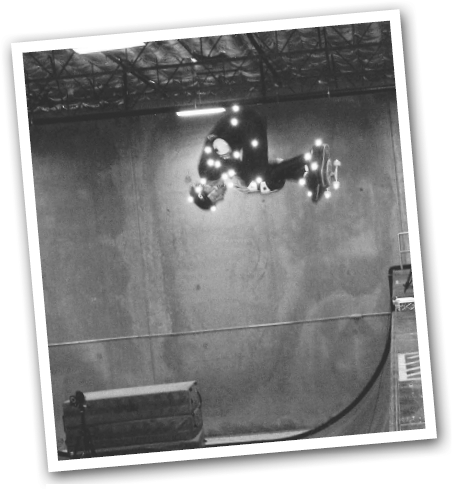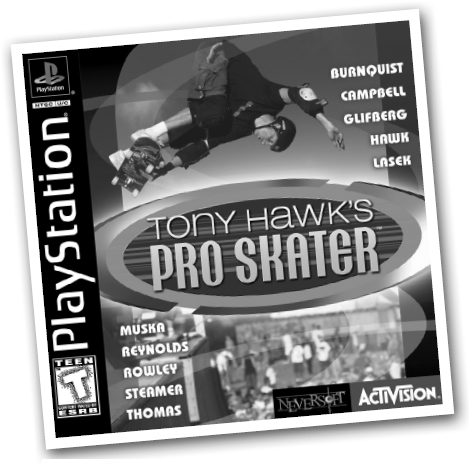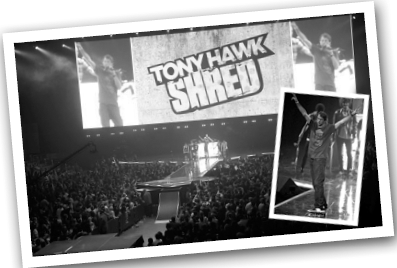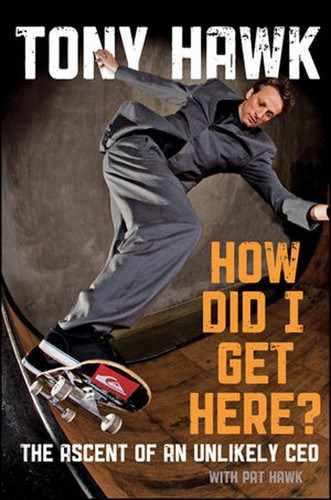Note
Your videogame is great, but you should try skateboarding. I mean I know you are good in the game, but you should try it in real life. I bet that you would be pretty good.
In early 1997, I was approached by a software programmer about doing a skateboarding video game for PCs. I'd always been a computer and video game geek, and of course I gravitated toward any digitized version of skating. The first, Atari's 720 Degrees arcade game, came out in 1986, and I was addicted to it. The next year, Electronic Arts brought out Skate or Die! for the Commodore 64, one of the original desktop computers, which finally gave me a chance to play a skateboarding game at home.
It took 10 years for another decent skate game to land: Sega's Top Skater, a huge device available only in arcades. You stood on a skateboard, held on to rails, and controlled the virtual rider with your feet as he sped downhill. It was mostly a racing game, though—not really a skate game. And you needed to pour a long stream of quarters into it.
The programmer who approached me was in the very early stages of creating a software engine for a skateboarding game, and he needed to partner with an established developer. I was pretty sure that with my help we could create something substantial. We took meetings with a few big companies, including Midway and Nintendo, but they were resoundingly discouraging.
An early meeting with Midway was both disheartening and humiliating, as if we were being grilled by a group of professors who doubted our central thesis—that a skateboarding video game might be profitable. For an hour, they questioned every assertion we made. They said skateboarding wasn't popular enough, that skate tricks wouldn't translate to video game controls. Nintendo rejected us with more tact, but they also showed zero interest. After those meetings, the programmer simply gave up and wished me luck.
But the exercise planted a seed. The more I looked into it, the more I became convinced that technology had advanced enough to create a video game that would attract hard-core skaters and maybe even the general public. And while those first few meetings had felt to me like lynchings, apparently word got around that I was interested in working on a skateboarding video game from the ground up. Within a year, I started receiving some encouraging phone calls.
Before long, I was on a plane to New York to meet with Take-Two (future publishers of Grand Theft Auto). I liked what I saw, but they had a long way to go, and it seemed to me that their game direction was uncertain.
In September of 1998, I got a call from a consultant in L.A. who was working with Activision in Santa Monica. He asked if I would meet with them and their development subcontractor, Neversoft, about a game they already had in the works. They were focused on designing the game for PlayStation. Although PlayStation was clearly the most popular platform at that point, I was leery. I owned and played the three main consoles available of the era—Nintendo 64, PlayStation, and Dreamcast—but liked Nintendo's best because of its graphics.
But the meeting went well, and I was immediately impressed. For one thing, there were a lot of serious skaters on the Neversoft design team, and they were insistent that the characters resemble real skaters doing real tricks. Also, they'd done some demographic research and understood that skateboarding had the best marketing potential among the various action sports. Unlike surfing and snowboarding, skaters were geographically widespread, and they tended to be more devoted than the other subcultures.
Although the game was in the early stages, the controls were intuitive and the engine was perfect for skateboarding. (Neversoft had originally designed it for a game called Apocalypse, starring Bruce Willis, but that one flopped.) I was confident that with my input this could be the best skateboarding video game ever created. I agreed to put my name on it and start working.
First, though, we had to work out the financial details. Activision offered me a one-time buyout for the permanent use of my name and likeness on the game. It was a substantial amount of money, and my agent at the time encouraged me to take it, even though a royalty deal (in which I'd get a percentage of every game sold) would earn me more money in the long run if the game turned out to be a hit.
Fortunately, my income-to-mortgage ratio had finally reached a manageable stage, so I wasn't desperate for cash. Also, I could feel it in my bones that the game had potential to be a bestseller. I turned down their offer of a one-time buyout and gambled on royalties instead.
That turned out to be the best financial decision I've ever made. Within two years, I'd made 10 times their initial offer.
We spent more than a year in development. Every time Activision released a new "build," I played it all the way through and gave feedback. It was important to me that that we populate the virtual world with real skaters (meaning real-life pros) wearing real skate clothes, skating at real skate spots, and riding real gear adorned with real logos. But beyond style, I also wanted to make sure the tricks themselves were legitimate—that if they showed someone doing a Smith grind, for instance, they'd get the whole thing right: not just how the board hits the rail, but also the skater's style and positioning.
"The coolest thing for us was that Tony was game-savvy," Dave Stohl, who oversaw production of the game for Activision, said in a recent interview. "We were totally surprised. Neversoft did an awesome job—the magic was theirs. But Tony was more involved as a licensor than anyone I've ever seen, before or since."
I picked a group of pro skaters to include as characters, largely based on their skills, personalities, and diversity. I felt like our roster represented skateboarding well. Each one got to pick his or her own outfit and special trick, and I was thankful that they all trusted my instinct even if they hadn't seen the game before agreeing to be included. (In the first couple of releases, each pro got a cut of the royalties, and they made some pretty good money.)
To get the skaters to look as realistic as possible, we tried to use motion-capture filming. We wore funny suits with iridescent balls attached to pivotal body parts. As we skated, an array of stationary cameras would record every move from about two dozen different angles. A computer would compile the various perspectives and churn out a 3-D rendering. Mocap was still in its infancy, so it didn't work out exactly as planned. I bailed on one run and my runaway board slammed into a camera. It took them four hours to recalibrate the system.

The skin-tight "mocap," or motion capture, suit is as unflattering as it is uncomfortable.
In the end, the mocap didn't translate well to what Neversoft had already programmed, and the animators ended up mainly depending on existing skate footage for reference. But they were so good that nobody could tell the difference. By luck, I landed my first 900 just weeks before the game went to final submission, and they managed to animate it using video footage and squeezed it in at the last minute.
The music was another important aspect. We were already in uncharted territory, so Activision gave us permission to use the music that had been skateboarding's soundtrack in the late 1970s and early 1980s: punk rock. I was stoked to expose a new crowd to the tunes I'd grown up with, and the first two versions of the game featured bands like the Dead Kennedys, Suicidal Tendencies, The Vandals, Bad Religion, and Rage Against the Machine. We didn't have to rely on hits or shell out outlandish licensing fees, because the game was all about skateboarding. We were proud of our counterculture pursuit, and these were its anthems.
Activision released Tony Hawk's Pro Skater in 1999. By the time it hit the shelves, I was more excited than nervous. I was confident it would be well received because I'd played it so much and had shown it to friends whose opinions I trusted—people who'd tell me the truth if they thought it sucked. Everyone who tested it liked that they could make the riders do actual tricks, that they could roam freely around the various skate landscapes, and that the central goal was to complete original tricks and improve your own performance. Unlike other sports video games available at that time, it wasn't about beating someone else, or even the machine—although that was an option if you wanted it. You were basically competing with yourself, just like all skaters do every day.
I also had confidence that it would find an audience beyond the action-sports world. The graphics were good, the action was good, the music was good—a complete package.

This is the cover for my very first video game, Tony Hawk's Pro Skater. Courtesy of Activision.
Looking back, I'm still not sure if I was prescient, or just really, really lucky. More of the latter, probably. Either way, the game was a hit. It won a bunch of industry awards (Action Game of the Year from Electronic Gaming Monthly magazine, PlayStation Game of the Year from CNET's gamecenter.com, among others).
Note
Hi Tony:
My roommate is a very talented film student. Your stupid video game ruined his life. He locked himself in his room for two weeks and would not leave until he beat the game, and as a result he failed out of college. We're wondering if you'd pick up his share of the rent?
"For Activision, THPS was the game," Stohl said. "The initial expectations were that we'd sell 500,000 to 700,000 units. But then we released it, and every week the buzz kept growing and growing. You could see it spreading through word of mouth."
It ended up selling more than 7 million copies.
The first release did very well, but the second release, Tony Hawk's Pro Skater 2, was an even bigger hit, especially among serious gamers. According to the review-aggregation web site Metacritic.com, THPS2 was the best-reviewed video game of the decade, with an average rating of 98 out of 100. It was the second-best selling game of 2000, and at one point was No. 1 on the bestseller list while the first game was still in the top five. Activision sold more than 6.5 million copies of the second game in the first three years of its release.
From 1999 to 2007, Activision released at least one game a year:
1999 Tony Hawk's Pro Skater
2000 Tony Hawk's Pro Skater 2
2001 Tony Hawk's Pro Skater 3
2002 Tony Hawk's Pro Skater 4
2003 Tony Hawk's Underground
2004 Tony Hawk's Underground 2
2006 Tony Hawk's Project 8 (and Tony Hawk's Downhill Jam for Wii)
2007 Tony Hawk's Proving Ground
The games spawned a steady stream of competing action-sports titles vying for a share of this new market, and I'm still proud to have helped create a gaming genre that helped to solidify skating's place as a legitimate sport—in the real world as well as the virtual world. And despite an ever-growing list of competitors, the THPS series remains the best selling action-sports franchise of all time.
After eight years, the Neversoft development team was feeling burned out on the Tony Hawk skateboarding game control scheme. I don't blame them. Also, they were shifting focus to the amazingly successful Guitar Hero game.
But I wanted to jumpstart the game, so I brought an idea to Activision that had been rolling around in my head for a few years: make a skateboard-shaped controller that people could stand on to control what they see on screen. The industry was already moving in that direction, with motion-based controllers like Nintendo's Wii and peripheral-based games like Guitar Hero and Garage Band.
I ran the idea by Dave Stohl, now the company's executive vice president of studios. Dave jumped on it. He put a new Activision development team in charge—Robomodo in Chicago—and we hit the reset button on the franchise. I knew it would be risky, since nothing like it had been tried before, but I figured it was like learning a new skate trick: if you want to progress, you have to be willing to slam.
Note
DEAR TONY HAWK,
I LOVE TO PLAY YOUR GAMES. BUT MY MOM WON'T LET ME PLAY IT BECAUSE IT HAS SMOKING AND CUSSING.
With the new direction, we had to go back to square one with almost all facets of the game. The first and most important task was designing the controller. We went through many incarnations, and Robomodo now has a hilarious graveyard of prototypes in their office, some of which are downright embarrassing. My favorite was a blank skateboard deck with trackballs on it to slide your foot across. It was almost as hard as real skating and would have definitely thrown people on their asses. We settled on a device that resembles a skate deck (a little shorter and thicker than the real thing) and responds to motion via two accelerometers and four infrared sensors. Only after they settled on a board design did Robomodo get to work on the software, which had to be customized for this strange new controller. We decided to name it Tony Hawk: RIDE.

The announcement of my latest game, Tony Hawk: SHRED, was held in L.A. at Staples Center as part of an Activision mega-proportional debut party.
Some hardcore gaming critics were pretty brutal when the game debuted in November 2009, writing it off as a failed novelty. Admittedly, there were some software quirks, but user reviews were overwhelmingly positive, especially those from the Wii crowd. We sold more than one million units in the first three months, and we quickly went to work on a sequel that would fix any glitches. The new version, Tony Hawk: SHRED, will also venture into the mountains, where players can pretend they're snowboarding.
Note
DEAR TONY,
I HAVE A LOT OF YOUR GAMES, LIKE TONY HAWK'S PRO SKATER 3, TONY HAWK'S PRO SKATER 4, TONY HAWK'S PROVING GROUND, TONY HAWK'S UNDERGROUND, AND TONY HAWK'S UNDERGROUND 2. MY OLDER BROTHER IS THE REAL TONY HAWK FAN. I'M MORE INTERESTED IN INSECTS.
At the time this book is being written, I'm in the twelfth year of my relationship with Activision. Here's a shocking stat: They've released 79 different versions of my game across the various gaming platforms, including mobile and online adaptations. It's been an intensely satisfying (and ridiculously lucrative) experience. I obviously hope the marriage will continue for a long, long time.
